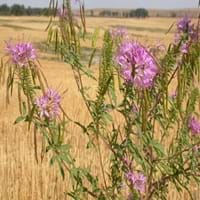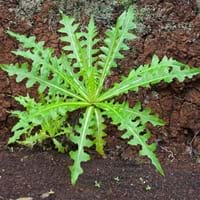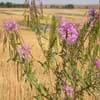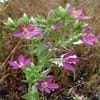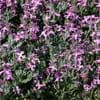Type
Herbs, Vegetable
Shrub
Origin
South America, Argentina, Brazil
Europe
Types
Skunk weed, Navajo spinach
Not Available
Habitat
foothill woods, open Woodlands, Prairies, Roadsides
Cultivated Beds, Waste areas
USDA Hardiness Zone
3-10
6-9
AHS Heat Zone
12 - 1
Not Available
Sunset Zone
1a, 1b, 2a, 2b, 3a, 3b, 4, 5, 6, 7, 8, 9, 10, 11, 12, 13, 14, 15, 16, 17, 18, 19, 20, 21, 22, 24
Not Available
Habit
Upright/Erect
Clump-Forming
Minimum Height
Not Available
Minimum Width
Not Available
Flower Color
White
Yellow
Flower Color Modifier
Bicolor
Bicolor
Leaf Color in Spring
Green
Light Green, Gray Green
Leaf Color in Summer
Green
Light Green, Gray Green
Leaf Color in Fall
Green
Not Available
Leaf Color in Winter
Light Green
Light Green
Leaf Shape
Small elliptic
Arrowhead
Plant Season
Summer
Not Available
Sunlight
Full Sun
Full Sun, Partial Sun
Growth Rate
Fast
Very Fast
Type of Soil
Sand
Clay, Loam, Sand
The pH of Soil
Acidic, Neutral
Acidic, Neutral, Alkaline
Soil Drainage
Well drained
Average
Bloom Time
Summer, Late Summer
Late Spring, Early Summer
Tolerances
Cold climate
Drought
Where to Plant?
Container, Ground
Ground
How to Plant?
Seedlings
Seedlings
Plant Maintenance
Low
Medium
Watering Requirements
Medium, Requires regular watering, Requires watering in the growing season, Water occasionally
Requires regular watering
In Summer
Lots of watering
Lots of watering
In Spring
Moderate
Moderate
In Winter
Average Water
Average Water
Soil pH
Neutral, Slightly Acidic
Neutral
Soil Type
Sandy, Well drained
Moist
Soil Drainage Capacity
Sandy, Well drained
Well drained
Sun Exposure
Full Sun
Full Sun
Pruning
Remove damaged leaves, Remove dead or diseased plant parts
Remove damaged leaves, Remove dead branches, Remove dead leaves
Fertilizers
All-Purpose Liquid Fertilizer, fertilize in growing season
All-Purpose Liquid Fertilizer
Pests and Diseases
Insects, Leaf spot
Red blotch
Plant Tolerance
Cold climate
Drought
Flower Petal Number
Single
Single
Fragrant Bark/Stem
Yes
No
Foliage Texture
Medium
Medium
Foliage Sheen
Matte
Matte
Attracts
Bees, Butterflies
Butterflies
Allergy
Not Available
Not Available
Aesthetic Uses
Landscape Designing
Showy Purposes
Beauty Benefits
Not Available
Not Available
Environmental Uses
Air purification, Food for insects, Shelter for wildlife
Air purification
Medicinal Uses
Fever
Anxiety, Cough, Insomnia, Rheumatism, Wounds
Part of Plant Used
Flowers, Leaves, Seeds
Flowers, Leaves
Other Uses
Decoration Purposes, Making deodorants, Used as a dye, Used As Food, Used for its medicinal properties
Showy Purposes
Used As Indoor Plant
Yes
No
Used As Outdoor Plant
Yes
Yes
Garden Design
Edible, Herb
Not Available
Botanical Name
CLEOME hassleriana 'Helen Campbell'
LACTUCA serriola
Common Name
Cleome, Spider Flower
Compass Plant, Horse Thistle, Prickly Lettuce
In Hindi
Cleome serrulata
Prickly Lettuce
In German
Cleome serrulata
Feigensalat
In French
Cleome serrulata
laitue scariole
In Spanish
serrulata cleome
lechuga espinosa
In Greek
Cleome serrulata
φραγκοσυκιές Μαρούλι
In Portuguese
serrulata Cleome
alface espinhosa
In Polish
cleome serrulata
Kolczasta Sałata
In Latin
Cleome serrulata
Opuntia Lactuca
Phylum
Magnoliophyta
Magnoliophyta
Class
Magnoliopsida
Magnoliopsida
Order
Brassicales
Asterales
Family
Cleomaceae
Asteraceae
Clade
Angiosperms, Eudicots, Rosids
Angiosperms, Asterids, Eudicots
Tribe
Not Available
Cichorieae
Subfamily
Not Available
Not Available
Number of Species
Not Available
Not Available
Properties of Cleome serrulata and Prickly Lettuce
Wondering what are the properties of Cleome serrulata and Prickly Lettuce? We provide you with everything About Cleome serrulata and Prickly Lettuce. Cleome serrulata has thorns and Prickly Lettuce doesn't have thorns. Also Cleome serrulata does not have fragrant flowers. Cleome serrulata has allergic reactions like Not Available and Prickly Lettuce has allergic reactions like Not Available. Compare all the properties and characteristics of these two plants. Find out which of these plant can be used as indoor plant. If you are interested to decorate your house and garden, find out aesthetic uses, compare them and select the plant which will beautify your surrounding. Along with beautification, try comparing medicinal and edible uses of Cleome serrulata and Prickly Lettuce and you can choose the plant having best and most benefits.
Season and Care of Cleome serrulata and Prickly Lettuce
Season and care of Cleome serrulata and Prickly Lettuce is important to know. While considering everything about Cleome serrulata and Prickly Lettuce Care, growing season is an essential factor. Cleome serrulata season is Summer and Prickly Lettuce season is Summer. The type of soil for Cleome serrulata is Sand and for Prickly Lettuce is Clay, Loam, Sand while the PH of soil for Cleome serrulata is Acidic, Neutral and for Prickly Lettuce is Acidic, Neutral, Alkaline.
Cleome serrulata and Prickly Lettuce Physical Information
Cleome serrulata and Prickly Lettuce physical information is very important for comparison. Cleome serrulata height is 120.00 cm and width 120.00 cm whereas Prickly Lettuce height is Not Available and width Not Available. The color specification of Cleome serrulata and Prickly Lettuce are as follows:
Cleome serrulata flower color: White
Cleome serrulata leaf color: Green
Prickly Lettuce flower color: Yellow
- Prickly Lettuce leaf color: Light Green and Gray Green
Care of Cleome serrulata and Prickly Lettuce
Care of Cleome serrulata and Prickly Lettuce include pruning, fertilizers, watering etc. Cleome serrulata pruning is done Remove damaged leaves and Remove dead or diseased plant parts and Prickly Lettuce pruning is done Remove damaged leaves, Remove dead branches and Remove dead leaves. In summer Cleome serrulata needs Lots of watering and in winter, it needs Average Water. Whereas, in summer Prickly Lettuce needs Lots of watering and in winter, it needs Average Water.
